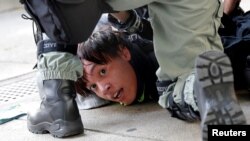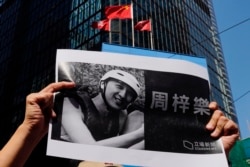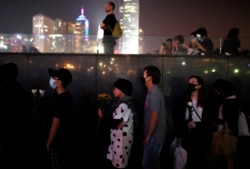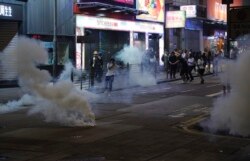Protesters in Hong Kong, angry over the death of a demonstrator on Friday, smashed windows at a subway station and shopping mall Sunday.
The Associated Press reported that several people were arrested and that police fired tear gas as occasional scuffles broke out between police and demonstrators.
Student died days after fall
Candlelight and prayer vigils continued throughout the city Saturday to mourn the death of 22-year-old Chow Tsz-lok, a student at Hong Kong University of Science and Technology, who died in a Kowloon hospital Friday, four days after he fell one story in a parking garage in the Kowloon district.
Police had been trying to clear protesters from the area and fired several rounds of tear gas. Chow is believed to be the first person to die from injuries sustained during five months of clashes with police as protesters demand a democratic government and revamped policing.
University president Wei Shyy has asked for an independent and thorough investigation into the circumstances around Chow’s fall. Shyy added that police had to explain why an ambulance was delayed entering the car park after Chow was injured. Widely circulated videos that were shared at a university forum with Shyy show what appears to be police blocking an ambulance in the area.
Police have denied accusations that they blocked an ambulance or that they had chased Chow, leading to his injuries. They have asked that a coroner hear the case.
Hong Kong police spokeswoman Suzette Foo told reporters police entered the car park at 1:04 a.m. November 4 to disperse protesters who had thrown objects at officers. She said officers learned of Chow’s fall and injuries only after seeing firefighters treating him.
That answer and inconsistencies concerning the police response have enraged residents.
Protesters have called for a general strike on Monday throughout the city, hoping to paralyze the financial capital as they did August 5. Then, frustrated by nearly two months of near-silence from the government, protesters moved quickly through the city to disable parts of the airport, disrupting more than 200 flights, blocking major highways and roads and rail lines, bottling up a transport tunnel, and occupying shopping malls.
Protesters are hoping for an even bigger, more unified strike on Monday.
Many who attended a memorial vigil in the parking garage on Friday shared theories and frustrations with what had happened.
“We think it is not an accident,” said Ceci, a 20-year-old student, who attended a vigil for Chow in the parking garage where he fell. Like most residents, she would not disclose her full name for fear of being arrested.
“A normal person would not jump from the third floor to the second. Actually, Hong Kong citizens don’t believe in the police anymore,” she said.
Six months of protests
Despite months of violent clashes, Chow is the first person to die during a clash between protesters and police. A teenager was shot by an officer and seriously injured on October 1, and another young person was shot three days later, but both protesters survived. Several young people who supported the movement took their own lives this summer.
Unlike the gunfire incidents, the details and reasons behind Chow’s injuries have confused and discouraged residents already furious with police methods of crowd control.
In an effort to disperse large street marches and blockades against a proposed bill to allow extraditions to mainland China, police responded to some thrown bricks and road barricades with massive displays of force.
It has become routine for police to fire tear gas in residential neighborhoods, and use batons to subdue people under arrest. The government’s refusal to rein in officers transformed the movement from one concerned with an extradition law into a wider effort for democratic governance and an independent inquiry into policing.
In the incident early last week in which Chow died, police said officers fired 44 rounds of tear gas, 11 rubber bullets, and other so-called nonlethal weapons during their attempt to repel demonstrators in the Tseung Kwan O district. Police claimed that people had thrown objects at the officers.
Hours after police announced Chow’s death on Friday, residents speculated why the college student was in the garage, why he moved from the third floor to one below, and whether he was being chased. The decision by the parking garage’s owner, Link Real Estate Investment Trust, to release security footage from the CCTV cameras provided more grist for residents who swapped hunches and suspicions online and in mass gatherings to honor Chow.













